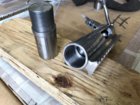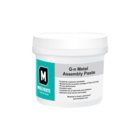
The action is already damaged. Your only real fix is to bore the tenon out and then change the threads to true them back up.
Yes, the threads will no longer be “standard”, but you are probably beyond that point. The object now is to make the action serviceable again.
Last year a fellow shooter tried to screw a Panda barrel into his new Bat DS. For those that do not know, Bat uses a tighter pitch diameter than Kelbly, even though both are considered “1.062 18 tpi”. He got it half way in with an action wrench and it stopped. There was no moving it after that.
He took it to someone who ended up boring half the threads out of the action. The action was ruined. He asked me what he could do?
I chucked the action up just as if I was going to true the threads and face. I bored out the bad threads and then established a 20 tpi. It came out pretty nice.
I even made him a gage for the thread, but told him that this thing was now totally oddball, and be thankful I was able save it.
Then he turns around a month ago and tries to sell it. Needless to say, not many wanted it.
So my best friend offered him a very reasonable price, knowing I could install barrels in it, and knowing since I did the fix, it would be fine.
Needless to say, I will no longer do any favors for this shooter. I did it for him so he would at least have a serviceable action. He returned the favor by trying to make a buck.












